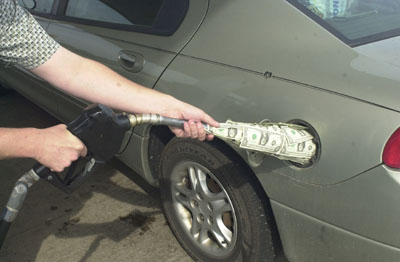By Timothy Cox
tcox@dailystandard.com Higher gas prices affect nearly everyone, households, commuters, businesses and governments, as energy costs gobble up a larger portion of their budgets.

Every time a gallon of gasoline at the pump rises just a penny, Americans spend an additional $4 million daily, according to U.S. Energy Department statistics. That reduces disposable income and holds back economic growth, economic experts say.
But people get hit not only in their own pocketbooks, but also end up shouldering the burden for business and government. Businesses tend to pass on higher energy costs to consumers while taxpayers foot the bill for higher fuel prices in government settings, like school buses and police cars.
Auglaize County Engineer Doug Reinhart said even though his department uses more diesel and gasoline than any other county department, where the budget really gets hit is in the cost of asphalt.
The price of hot mix used to patch and pave county roads has risen from about $29 per ton to $33.50 per ton, Reinhart said. That adds up to big bucks for a summer paving program that uses 35,000 tons of the stuff. Asphalt prices are directly tied to crude oil prices, which have been at or near historic highs in recent weeks. While gasoline pump prices have yet to show the effects of the surge in oil prices, paving contractors are well aware of the situation.
When bidding on local government paving contracts, most contractors are given only a short window of time to lock in prices due to price spikes.
On the gasoline and diesel side, Reinhart said his office tries to play the market, buying fuel in 6,000-gallon allotments when prices are a bit lower. The engineer's office uses about 100,000 gallons of fuel -- mostly diesel -- annually, Reinhart said. The county sheriff's department is the next-largest fuel consumer, using gasoline mostly for cruisers.
If fuel and asphalt prices had been the same this season as a year ago, Auglaize County could have paved 6.5 more miles of road and replaced two additional small bridges, Reinhart said.
Jeff Long, the village administrator in Rockford, said officials there planned for higher fuel costs this year by appropriating additional money to meet those expenses. Still, higher fuel costs mean fewer dollars to spend elsewhere, Long said.
"It makes quite a bit of difference," Long said. "This year, we've probably seen 20 percent higher costs for fuel. It eats into the budget."
Asphalt prices have risen about 15 percent or so since spring, Long said.
"You either have to find more money or reduce what you can do," said St. Marys Safety-Service Director Mike Weadock.
The city has seen higher fuel costs for a huge fleet of vehicles that includes police cruisers, fire trucks, garbage trucks and street and utility crews, Weadock said.
In Celina, where budgets are already tight, Auditor Pat Smith said fuel costs probably are straining some departments but said city officials do not specifically track fuel costs.
Unlike some governments that buy gas and diesel in bulk quantities and store it, Celina buys its fuel from local stations at regular pump prices, minus state and local taxes.
In the business world, fuel prices affect shipping costs and other industries dependent on transportation. Even corporate giant Wal-Mart blamed high energy prices as one of the reasons it lowered August sales forecasts. Wal-Mart's problem isn't its own energy costs, the company said, but rather that consumers are pinched for spending money because of sky-high gas prices.
"The low-income customer is badly affected by the robbery at the gas pump," Retail Forecasting Group's Kurt Barnard said in an Aug. 23 Reuters News Service story.
Gas prices are influenced by a number of factors, including supply and demand, oil prices, refining costs, taxes and competition among gas station owners.
Fuel prices are holding back the economic recovery, an economist for the U.S. Conference Board said in an Aug. 19 USA Today report. The board compiles a Composite Index of Leading Economic Indicators that has dropped the past two months.
"The latest decline ... reflects a loss of forward momentum," economist Ken Goldstein said. "There are growing concerns about the high cost of gasoline and milk, as well as worries about where economic growth will come from now that tax refunds are spent and short-term interest rates are rising."
Any time gasoline prices rise, it means bad news for local economies and even the national economy because most of that money is going out of the country, said a 2001 study done at the University of Illinois-Champaign. That study suggested a 25-cent spike in per-gallon gas prices could drain $821 million in industrial sales, 19,000 jobs and $535 million from household incomes just in the Chicago metropolitan area over the course of a year. |

